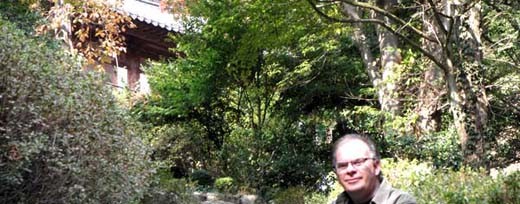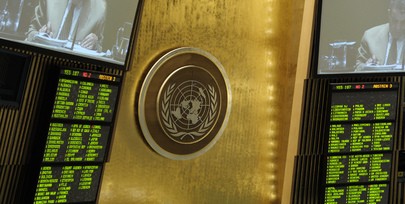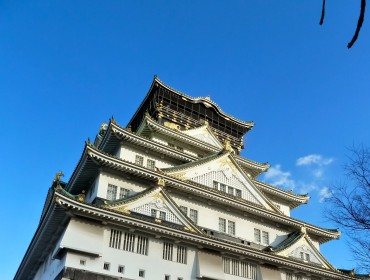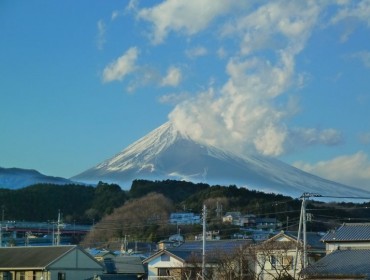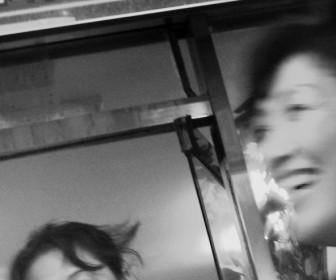By R.M. Adamson
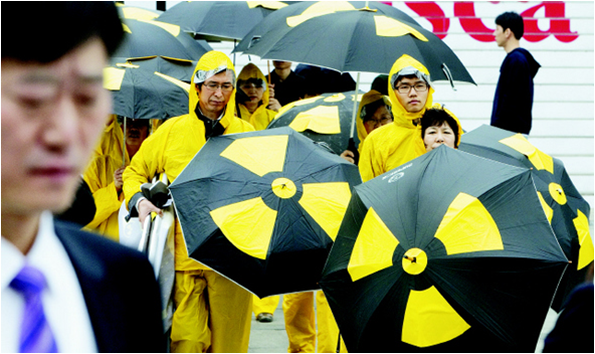
The early spring shower that fell outside my window on Thursday, April 7, was radioactive, or so I was told. Here in Korea, about 130 schools decided to close, and at others parents clogged the streets by driving their kids to school rather than letting them walk in the rain. I didn’t have any appointments that day, so I stayed in, but I wasn’t worried. The prevailing wind patterns have sent most of the radiation across the Pacific, so it’s most likely that my people back in California got a bigger dose than I would have here in Seoul.
The cherry blossoms are starting to bloom in this part of the world, and these are the weekends when many couples will stroll beneath the trees with a romantic partner, reinvigorating a relationship or making an attempt to build happy memories. Shintaro Ishihara, the mayor of Tokyo has expressed his view that the usual hanami tradition of drinking sake with friends beneath the boughs and among the falling petals would be unseemly this year and disrespectful to the wandering spirits of so many thousands dead beneath rubble or washed out to sea. (“This is not an era in which people at this time of year may drink viewing cherry blossoms, even during daytime.”)
I doubt that many people will follow his advice, as on another occasion he was heard saying that the quake and the tsunami were “divine punishment,” and found it necessary to apologize later. Similar idiocies were uttered by a certain Rev. Cho, the founder and pastor emeritus of the Yoido Full Gospel Church here in Seoul, and the American political commentator Glenn Beck. All of these men are, of course, asses.
Over in Japan, the actors who play well-known superheroes on television have been using their smartphones to send tweets to the children who are their fans and main source of livelihood, telling them to “Children, please endure these tough times just a little bit longer. Please, keep it up.” It’s commendable, but it just might beg the question in the minds of prepubescent Japanese kids: Just where was Ultra-man when all this shit was going down? And all the rest of the Power Rangers—tidal waves, mass evacuations, and nuclear plant explosions, isn’t this just the kind of thing those guys are normally all geared up for?
_______________
I grew up in earthquake country. All my childhood and most of my adulthood was spent in Northern California, in and around the San Francisco Bay Area, and one might suppose that it would give me some special insight into what the people in Miyagi-ken and others in the surrounding area are going through. In fact, though, it doesn’t.
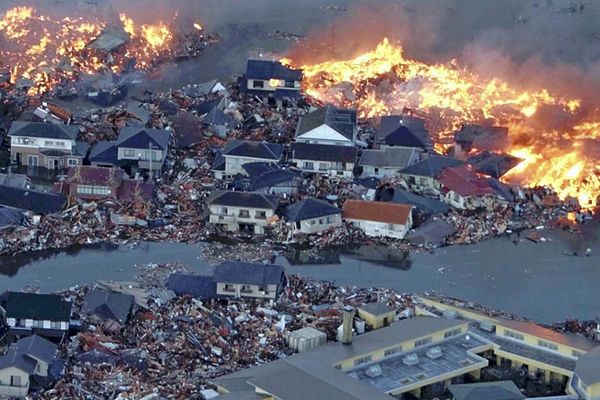
The scale of the devastation we’ve been seeing in Japan exceeds anything California has experienced since the Quake of 1906, when San Francisco burned completely to the ground. The city was rebuilt in no time at all, bridges were constructed and skyscrapers erected that gently sway during tremors rather than crack and collapse. Modern engineering techniques such as these helped see to it that when a similar quake hit 83 years later, the damage was much less severe and largely confined to historic buildings that had been exempt from the retrofit requirements mandated in the 70s. The final death toll of the Loma Prieta Quake of ‘89 was 62 people, and it was in stark contrast to what Japan would experience a half dozen years later at Kobe, where more than 6,000 people died beneath the rubble of collapsed buildings
Today, Kobe likely provides occasion for a lovely bit of nostalgia after the events of last month, with the triple whammy of the Big One with hundreds of aftershocks, a tsunami that demolished dozens of cities and small villages, and now an ongoing crisis from radiation leaks while workers try to contain a possible Chernobyl-style meltdown event. The exact death toll might never be determined precisely due to the thousands of bodies pulled out to sea by the receding waves, but estimates as I write this hover around 28,000. The quake and aftershocks destroyed thousands of homes and businesses, and it’s unknown how soon, or whether, rebuilding will begin in the worst affected areas.
These are things we all know, because by now, little more than a month later, we’ve seen the numbers and heard the analysis, watched the flood footage on YouTube and the rescue attempts on CNN and BBC. It’s been a period of heavy drama, vicarious drama for those of us not in Japan, 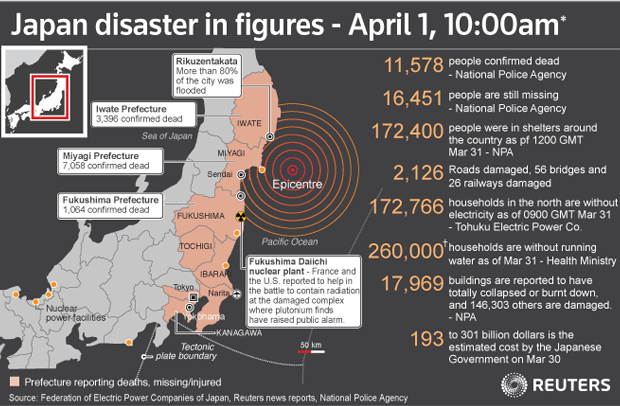 but sometimes a cause of anxiety for those of us with friends in the education field over there. A couple of my Facebook acquaintances quit their teaching gigs in Tokyo and hopped back over here to Korea, “at least until things calm down.”
but sometimes a cause of anxiety for those of us with friends in the education field over there. A couple of my Facebook acquaintances quit their teaching gigs in Tokyo and hopped back over here to Korea, “at least until things calm down.”
In fact, the question of whether to stay or go has been a topic of conversation among foreigners living in the greater Tokyo area. At least one blogger, Hello Sandwich, decided to return to her home in Sydney, “while nuclear concerns pass. It’s only a precaution.” From there, she continued to post disaster relief resources and coordinate fundraising. Some companies have experienced disruptions from the sudden loss of foreigners on their staff and among those who stay behind, there is at least a bit of derision towards those who flee. As one writer put it, “Stay when the times are good, leave when they get tough.” A new word has been coined, at least partly tongue-in-cheek:
Flyjin: A foreigner or expat in Japan (gaijin) who heads for Narita (or Kansai) at the first sign of a nuclear holocaust. Not a Japanese word and not familiar to or used by Japanese, flyjin was coined by English-speaking Twitter users.
Flyjin.com is serving as a repository for “Why I Fled” narratives, though there are also a few “Why I Stayed” stories as well.
_______________
As is true here in Korea, Japan also has a thriving expatriate blogger community. Some, like Kurashi and Japan Probe, are giving real-time analysis of news events, while others are promoting and organizing donation drives for relief efforts. A few more are personal blogs, written primarily to keep friends and family updated on the writer’s life overseas, and among these nearly every blog has an entry for March 12 to let people know they are safe and doing well.
Lea Jacobsen tutors English now, but she formerly worked as a nightclub hostess. Her memoir, Bar Flower: My Decadently Destructive Days and Nights as a Tokyo Nightclub Hostess is available at Amazon.com. She blogs at Geisha, Interrupted. When the quake hit, she was deep underground in the Tokyo subway system.
“This is the strongest tremor I’ve ever felt in my life,” the old man, the first of anyone around me to speak in a complete sentence, quietly tells his friend, who nods in agreement. I take a closer look at his face. He appears to be about seventy.
Fuck.
Then more shaking. Passengers hold on to their seats, as if we are in a tin can that is being shaken up by some naughty kid. […]
Finally, finally the train starts to move.
The Marunouchi line usually runs underground, but makes a cameo appearances above street level at a few stations. The station we are heading to, Korakuen, happens to be above ground. As the train inches up towards daylight, I am in the front car, where a few people are now rushing up to accompany me there, to look out the window. As the train creeps above ground we all hold our breath.
“Daijoubu da sou.” The old man across from me tells his friend, as the city, still standing, comes into view. It looks alright.
“Sou mitain da na.” His friend responds. It seems like it does.
“Demo, kaeranai to wakannai na,” The first man is sure to qualify. But you don`t really know until you get home.
William writes Spam From Japan. He teaches English in Saitama, a northern suburb of Tokyo and several hundred kilometers from the worst affected areas.
I was just about to start marking my fifth graders’ classwork when the windows started rattling. Neither of the other two teachers in the staffroom had reacted, but I had stopped hunching over my desk and was bolt upright, looking around the room. As a foreigner from England, where we don’t have earthquakes, I often find myself more interested and worried about even the smallest tremors than the average Japanese person. […]
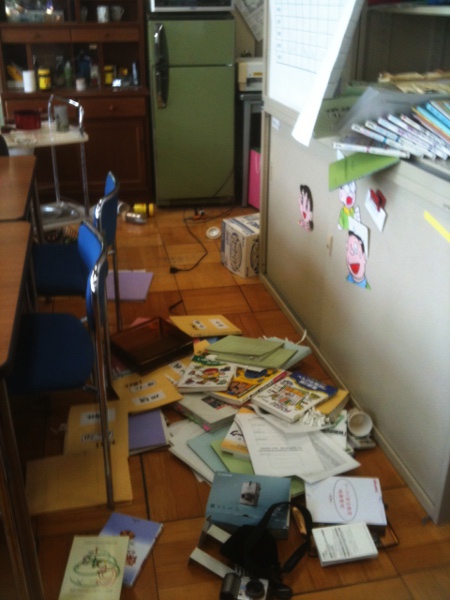
It continued, but I’ve been here long enough to see that too. Just the other day we had a smaller quake (7.2 magnitude, but much further away from civilisation) while I was teaching a class. The kids got under their desks for a few minutes, then we learned ‘earthquake’ in English.
This earthquake intensified. The vice principal realised something was wrong then and sprang to the PA system near her desk. The curriculum advisor threw open the staffroom doors and rushed out into the corridor. The whole building shook violently and things fell off the shelves. I braced myself against the white painted cupboards by the window and my desk.
There was a row of potted plants on the cupboards by the window. One by one, they rolled off and smashed. Mugs tumbled out of the cupboard in the hot drinks area and the photocopiers came away from the wall and smashed into the metal cases filled with English teaching material.
Blogger sixmats was in the middle of it all. He got out of Sendai with his wife about 10 days after the quake. A lot of his account is about waiting in lines for water or gas.
I waited and waited and after a five hours from the time I started I was able to get 2000 yen in gas which filled the tank of the small car over half way. I went back home.
My wife was in escape mode when I got back. Not only were we running low on supplies, but her parents were also not doing well. So we grabbed some things, returned the water and cabbage, and packed the car. We were not sure if we would come back home first or not at this point. My wife called her mom’s cousin, who was our contact, to get our car and he agreed to meet us near Yaotome. We got our car and not knowing what the roads would be like, left the city.
The traffic was horrendous in the norther part of the city, but that was because people were waiting in line for gas. The roads were surprisingly empty. What I did have to watch out for was where the roads met the bridges. The roads have all sunk so the roads are pretty beat up in those areas.
My area in Sendai still does not have running water.
Aleister Kelman is a graphic designer from the UK, working in Tokyo. Until recently, that is. His site includes photographs and a description of his March 11 adventure.
Many foreigners have fled Tokyo either for the south, their homes or elsewhere in East Asia. Today I am doing the same and heading to Hiroshima with a view to flying to Vietnam. You can throw caution to the wind, but not to a tsunami.
_______________
What we don’t know, of course, is how much and in what manner Japan will be changed by all this. It’s inevitable that nuclear power will remain the primary energy source in that country for years into the future, but it’s also a good bet that no new power plants will be constructed for a while, not just in Japan but elsewhere as well. Japan has the same number of nuclear power plants as the US, but contained in a land mass about the size of California. In the aftermath of the disasters, many will question that country’s over-reliance on nuclear energy when the Home Islands are so obviously prone to seismic instability.
The answer that is most often given is shikata ga nai, which variously translates as either “It can’t be helped,” or “There is no other choice.” This might actually have been true when the Fukushima plant was first constructed 40 years ago, but in this century an ever-increasing menu of energy sources are becoming available that need little more than the will to create an infrastructure to develop them. It’s not hard to imagine a Japan that says, “We will put every ounce of Japanese industrial might, capital, and organizational ingenuity behind alternative energy: wind power, solar energy, tidal generation, geothermal. Japan will change the world, just when the world needs to change. And it will make us rich.” It might be wishful thinking, a vague hope that something good and positive might possibly grow out of the chaos and tragedy.
I started out by remarking that my own experiences living in an earthquake region don’t allow me any unique perspectives regarding life after a disaster, and that’s true because my memories of the Loma Prieta Quake took place far from the epicenter, standing in the parking lot of my apartment complex (the safest place to be at such a moment) and watching a half meter of water climb out of the swimming pool all by itself. The aftershocks were few and minor, nothing like the hundreds that are still going on around Sendai, and the biggest inconvenience for me was that phone service was spotty for several days and anyone wanting to get into San Francisco itself had to drive a long route to the south via San Jose until the bridges and the BART system were running again.
What I can comment on, though concerns life prior to calamity—because, you see, in California, much like Japan, people live every day knowing that The Big One could strike at any time. Friends and family from other parts of the country expressed worry for us, but though we didn’t know the Japanese expression, I suppose we had our version of shikata ga nai: prepare for the worst and hope for the best.
Today I live on the far side of the Pacific, and while I do sometimes pass a thought for the safety of my brothers and nieces and nephews for whatever danger an earthquake might bring for them—I find instead that they also worry about me, living as I do right smack in the middle of the capital of a nation still at war with her neighbor. Which is more likely, a big earthquake in California or long-range artillery from North Korea? I really don’t know, and it doesn’t really matter because it can’t be helped, and for me, there is no other choice. This is where I live. It’s my home, at least for now.

So we walk about, sometimes beneath cherry blossoms, and sometimes dodging raindrops for fear of what they may carry. We build things, and construct lives for ourselves and for those we love, knowing all the while that it all, every bit of it, could turn to vapor with the next sunrise—or just a few minutes from now. We do what we can, which is often nothing, or next to that, because there is so little that can be done—and so we do our best not to think too much about it.
And this is how we go on.
 Print This Post
Print This Post
_________________________________________________________________________
 R.M. Adamson lives in Seoul. He sometimes makes repairs at Bobster’s House. Sometimes. His last piece for 3WM was “Ahyeon Shijang: the Disappearing Korean Outdoor Marketplace.”
R.M. Adamson lives in Seoul. He sometimes makes repairs at Bobster’s House. Sometimes. His last piece for 3WM was “Ahyeon Shijang: the Disappearing Korean Outdoor Marketplace.”



